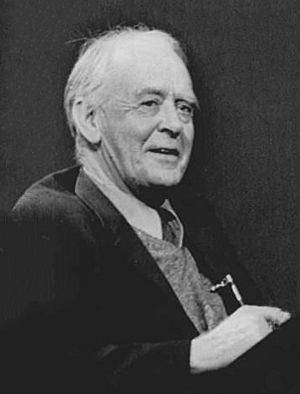John Richard Hicks facts for kids
Quick facts for kids
Sir John Richard Hicks
|
|
|---|---|

Hicks in 1972
|
|
| Born |
John Richard Hicks
8 April 1904 |
| Died | 20 May 1989 (aged 85) Blockley, England, UK
|
| Nationality | British |
| Institution | Gonville & Caius College, Cambridge London School of Economics University of Manchester Nuffield College, Oxford |
| School or tradition |
Neo-Keynesian economics |
| Alma mater | Balliol College, Oxford |
| Influences | Léon Walras, Friedrich Hayek, Lionel Robbins, Erik Lindahl, John Maynard Keynes |
| Contributions | IS/LM model Capital theory, consumer theory, general equilibrium theory, welfare theory, induced innovation |
| Awards | Nobel Memorial Prize in Economic Sciences (1972) |
| Information at IDEAS / RePEc | |
Sir John Richard Hicks (born April 8, 1904 – died May 20, 1989) was a very important British economist. He helped us understand how people make choices about what they buy, which is part of microeconomics. He also created a famous model called the IS/LM model in 1937. This model helps explain how a country's economy works as a whole, which is called macroeconomics.
His book Value and Capital, published in 1939, greatly improved ideas about how all parts of an economy fit together. This is known as general equilibrium theory. A special way to measure what people want to buy is even named after him, called the Hicksian demand function.
Who Was John Hicks?
John Richard Hicks was born in Warwick, England. He studied at Balliol College, Oxford. Later, he taught at several famous universities. These included the London School of Economics and the University of Manchester. He also taught at Nuffield College, Oxford.
His Big Ideas in Economics
Hicks made many big contributions to how we understand economics.
- The IS/LM Model: This model is one of his most famous ideas. It helps explain how money, interest rates, and the total amount of goods and services produced in an economy are connected. It shows how government policies can affect the economy.
- Understanding Consumer Choices: He studied how people decide what to buy. This helped economists understand how prices affect what people want.
- General Equilibrium Theory: This idea looks at how all markets in an economy work together. It shows how changes in one market can affect others. Hicks made this theory much clearer and more useful.
- Welfare Economics: Hicks also worked on ideas about how to make society better off. This part of economics looks at how policies can improve people's well-being.
Awards and Recognition
John Hicks received many honors for his work.
In 1964, he was made a Knight Bachelor. This means he could use the title "Sir" before his name.
In 1972, he won the Nobel Memorial Prize in Economic Sciences. He shared this award with another economist. They received it for their important work on general equilibrium theory and welfare economics. This prize is one of the highest honors an economist can receive.
Later Life
Sir John Richard Hicks passed away on May 20, 1989. He was 85 years old and died at his home in the village of Blockley, located in the Cotswolds.
See also
 In Spanish: John Hicks para niños
In Spanish: John Hicks para niños

